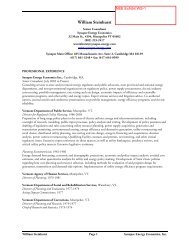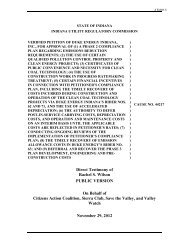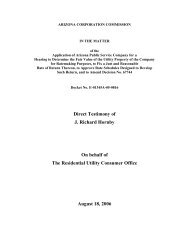Best Practices in Energy Efficiency Program Screening - Synapse ...
Best Practices in Energy Efficiency Program Screening - Synapse ...
Best Practices in Energy Efficiency Program Screening - Synapse ...
Create successful ePaper yourself
Turn your PDF publications into a flip-book with our unique Google optimized e-Paper software.
<strong>Energy</strong> efficiency screen<strong>in</strong>g<br />
practices should properly<br />
account for spillover effects,<br />
market transformation, risk<br />
benefits, the full useful life<br />
of efficiency measures, and<br />
be screened at the program<br />
level.<br />
comprehensive. <strong>Program</strong>s that are expected to have significant<br />
market transformation impacts should be provided with greater<br />
flexibility <strong>in</strong> the screen<strong>in</strong>g process, for example by allow<strong>in</strong>g<br />
market transformation programs to be implemented even if they<br />
do not pass the TRC test, but <strong>in</strong>clud<strong>in</strong>g their costs and benefits <strong>in</strong><br />
the PAC test applied at the portfolio level.<br />
It is also important to recognize that energy efficiency can<br />
mitigate various risks associated with energy plann<strong>in</strong>g and the<br />
construction and operation of large, conventional power plants.<br />
These risks <strong>in</strong>clude fuel price risk, construction cost risk, plann<strong>in</strong>g<br />
risk, reliability risk, and risks associated with new regulations. These risk benefits should<br />
be accounted for when screen<strong>in</strong>g energy efficiency programs, either through system<br />
model<strong>in</strong>g or through risk adjustments to the energy efficiency benefits.<br />
<strong>Energy</strong> efficiency measures produce sav<strong>in</strong>gs over the course of their useful lives.<br />
Depend<strong>in</strong>g on the measure, the useful life can be as long as 20 years or more. <strong>Energy</strong><br />
efficiency screen<strong>in</strong>g practices should use study periods that <strong>in</strong>clude the full life of the<br />
measures. Artificial caps on study periods or useful measure lives will skew the costeffectiveness<br />
analysis, and result <strong>in</strong> an under-<strong>in</strong>vestment <strong>in</strong> energy efficiency.<br />
Cost-effectiveness tests should be applied at the appropriate level <strong>in</strong> the plann<strong>in</strong>g<br />
process. Some states require that each energy efficiency measure be screened for<br />
cost-effectiveness, while others require screen<strong>in</strong>g at the program level, and others<br />
require screen<strong>in</strong>g at the portfolio level. We recommend that states do not require energy<br />
efficiency to be screened at the measure level, because this is overly restrictive and<br />
ignores the important <strong>in</strong>teractions between measures. In particular, it ignores the fact<br />
that some measures have benefits <strong>in</strong> terms of encourag<strong>in</strong>g customers to adopt other<br />
efficiency measures. As noted below, we recommend that energy efficiency programs<br />
be screened at the program level us<strong>in</strong>g the Societal Cost test or the TRC test, and that<br />
the entire portfolio of programs be screened us<strong>in</strong>g the PAC test.<br />
Furthermore, when energy efficiency measures are screened <strong>in</strong> the field (i.e., at the<br />
customer’s premises), they should be screened us<strong>in</strong>g the Participant’s Cost test, to<br />
provide the customer with relevant <strong>in</strong>formation regard<strong>in</strong>g which measures to adopt. The<br />
TRC test should not be used for field screen<strong>in</strong>g energy efficiency measures, because it<br />
is overly restrictive, can exclude measures that are cost-effective to customers,<br />
<strong>in</strong>creases the transaction costs of contractors and customers, creates lost opportunities,<br />
and h<strong>in</strong>ders the goal of achiev<strong>in</strong>g comprehensive, whole-house efficiency sav<strong>in</strong>gs.<br />
The <strong>Best</strong> Test(s) to Use for Screen<strong>in</strong>g <strong>Energy</strong> <strong>Efficiency</strong> <strong>Program</strong>s<br />
Five standard tests are used to evaluate energy efficiency programs, three of which are<br />
predom<strong>in</strong>ately used by states as the primary test for screen<strong>in</strong>g efficiency programs: the<br />
PAC test, the TRC test, and the Societal Cost test. The choice of which test to use will<br />
have a significant impact on the amount of energy efficiency resources that are identified<br />
as be<strong>in</strong>g cost-effective.<br />
| 6 <strong>Best</strong> <strong>Practices</strong> <strong>in</strong> <strong>Energy</strong> <strong>Efficiency</strong> <strong>Program</strong> Screen<strong>in</strong>g | www.nhpci.org







